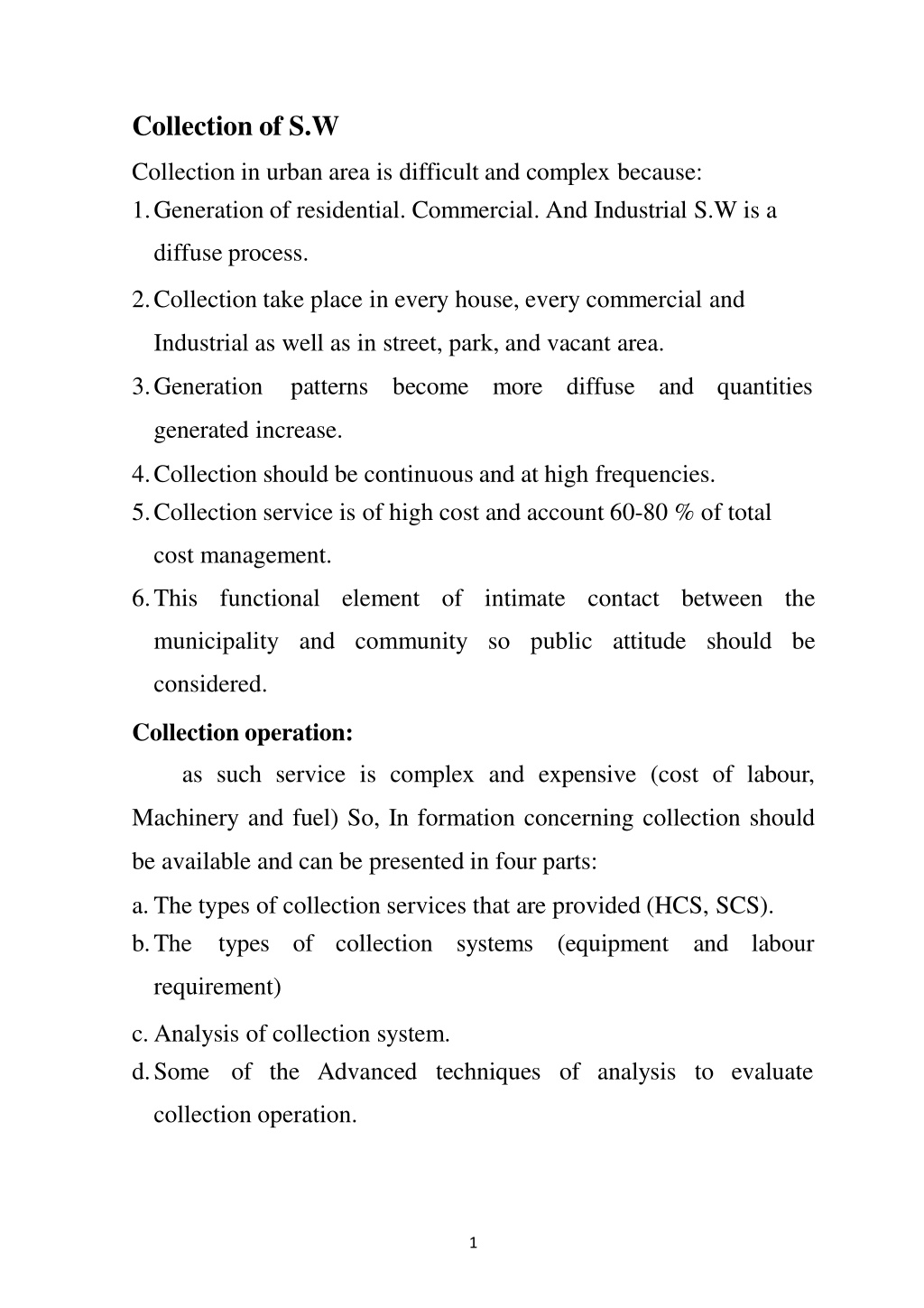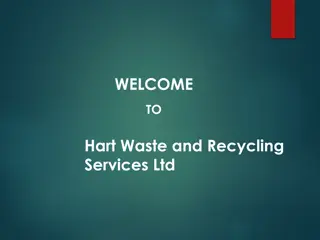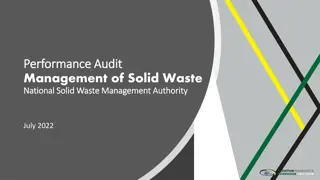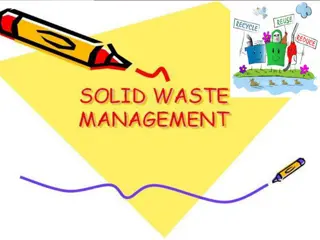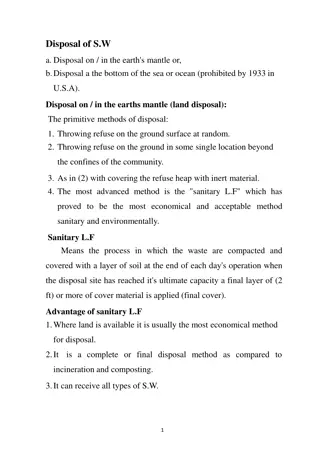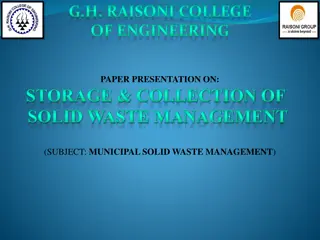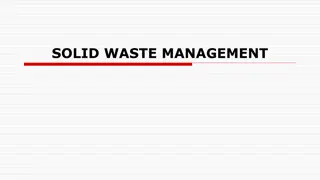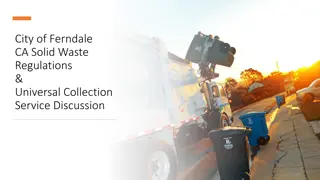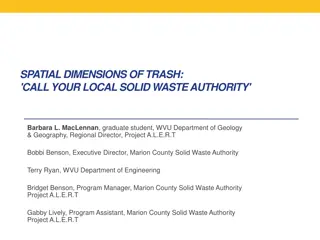Challenges and Strategies in Solid Waste Collection in Urban Areas
Solid waste collection in urban areas is complex due to the diffuse nature of waste generation, varied collection locations, increased quantities of waste, high costs, and the need for continuous service. Different collection methods and systems such as curbside pick-up, alley service, set-out set-back service, and backyard pick-up exist to address these challenges. Efficient waste loading into collection vehicles can be done manually or mechanically, depending on the type of waste being collected.
Download Presentation

Please find below an Image/Link to download the presentation.
The content on the website is provided AS IS for your information and personal use only. It may not be sold, licensed, or shared on other websites without obtaining consent from the author. Download presentation by click this link. If you encounter any issues during the download, it is possible that the publisher has removed the file from their server.
E N D
Presentation Transcript
Collection of S.W Collection in urban area is difficult and complex because: 1.Generation of residential. Commercial. And Industrial S.W is a diffuse process. 2.Collection take place in every house, every commercial and Industrial as well as in street, park, and vacant area. 3.Generation patterns become more diffuse and quantities generated increase. 4.Collection should be continuous and at high frequencies. 5.Collection service is of high cost and account 60-80 % of total cost management. 6.This functional element of intimate contact between the municipality and community so public attitude should be considered. Collection operation: as such service is complex and expensive (cost of labour, Machinery and fuel) So, In formation concerning collection should be available and can be presented in four parts: a.The types of collection services that are provided (HCS, SCS). b.The types of collection systems (equipment and labour requirement) c. Analysis of collection system. d.Some of the Advanced techniques of analysis to evaluate collection operation. 1
Collection service: Collection of S.W can be defined as a gathering or pickingup of S.W from various sources and the hauling of these wastes to the location where the contents of the collection vehicle are emptied including the unloading of these vehicles. Picking up of waste activities varies with the characteristics of the facilities, locations of generated wastes, the ways and means used for the on site of accumulated wastes and on the nature of the wastes. Municipal wastes collection services: For low rise, detached dwelling collect service used are: 1. Curb side pick up service: in this type of service is that container must be placed by the homeowner at the curb or in the alley if alley collection. The homeowner also responsible for returning the empty container to their storagelocation. -This service gives to each homeowner relatively uniform amount of services. - It eliminate the need for collectors to enter private property. -Many citizen dislike having their wastes to be set out at certain time, they object unsightly appearance on the street. -It require 1 driver and 1 or 2 crews to empty container in the collection vehicle. - It is possible for the crews to collect from both sides of the street. - It is quickest and more economical service ( low cost). 2
2. Alley service . Alley (narrow road serving houses) are part of acity planning. Alley storage of containers may be for individual house or common storage for many housed. Collection crew are responsible for empty container content into collection vehicle and returning empty container to its storage location. 3. Set out set backservice. It does require the collector to enter private property. It consist of: a.The collector ( set out crew) caries the full container from the resident storage location to the curb or alley before the collection vehicle arrives. b. The collector crew loads the refuse in the collection vehicle. c.The set back crew returns the empty containers to their storage location. 4. Back yard pick up (carry)service. The collector crew is responsible for entering the residents property and remove the wastes from their storage location using different methods for that such as: Wheeled caddy or the use of burlap carry cloth and carry them to the collection vehicle and dump it. It require 2-5 crews, 1 driver so it is costly and need longer time for collection. 3
Methods of loading the collection vehicle: May be classified as either Manual or mechanical depending on the collection vehicle: A- loading of residential waste include: - The direct lifting and carry of container and dumping into vehicle. - The rolling of loaded containers on their rim (when they are heavy). - The use of small lifts for rolling the container to the collection vehicle. - The use of large container or drop clothes in which wastes from small container are emptied before being carried to collection vehicles. B- commercial and industrial service : Also for medium and high rise building. - Usually they are use large mobile or stationary container with large compactor. The containers usually provided with rollers. They are rolled manually to the collection vehicle and emptied mechanically and return then to their storage location. Collection System: - Collection procedure require to satisfy: 1. Demand of public approach. 2. Municipal economy. 3. Public health and environmental requirement. Collection system to be well organized require. 1. Selection of trained labour. 4
2. Purchasing suitable vehicle, equipment. 3.Planning collection route. 4.Public attitude satisfaction. Collection system types: can be classified 1.The mode of operation which mostly related to the storage container types. 2. The equipment used. 3. The type of wastes collected. collection systems according to the mode of operation. 1. Hauled Container System. HCS 2. Stationary Container System. SCS 1.Hauled container system (HCS) - Can be defined as the system in which containers used for the storage of waste are hauled to the disposal site, emptied and returned to either there original location or some other location. For this the container usually of the roll-off large containers located in areas of high generation rates. 2.Stationary container system (SCS): Containers used for the storage of S.W ( usually of small size) remain at the point of generation except for occasional short trip to the vehicle (collection vehicle). 5
